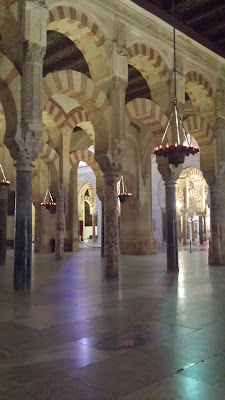Cordoba's earliest inhabitants pre-date the Bronze Age, so things have been happening here for a fair while. In Roman times, Cordoba was the capital of a Roman province and home to Roman philosophers such as Seneca. The ruins of a Roman temple were just round the corner from our abode. Ancient churches are on almost every street, but the most famous site of all is the Mezquita, the Mosque-Cathedral of Cordoba, and it was high on our list of places to visit. It's thought that the first place of prayer built on the Mezquita site was an early temple. It's certain that a Christian church was erected on the site by the Visigoths in the C7th. Some remnant pieces of this building are on display, the artistry of which made Kim comment that the Visigoths were obviously much less barbarian than we assume, and clearly needed a better PR team.
The Muslim Moors conquered the area in 711 AD, and Visigoth church was first divided into Muslim and Christian halves; an arrangement that lasted for over 70 years until the Christian half was purchased by the ruling Muslim Caliph of the time. In 784 AD, work to build the Great Mosque (the Mezquita) on the site began, and improvements continued for two centuries.

Cordoba is thought to have been the biggest city in the world by 1000 AD, with a population of a quarter of a million people, plus numerous libraries, universities and medical schools (which established some medical techniques that were only superseded in the C20th). As the most prosperous city of Europe, it outshone Byzantium and Baghdad. According to the
Rough Guide to Andalusia, the Mezquita had an original copy of the Koran and as a place of pilgrimage, it ranked fourth in sanctity after Mecca, Medina and Jerusalem. Eventually however, things declined and, in 1236, the Reconquista saw Cordoba reclaimed by Christians from the North. The Mezquita was turned into a Cathedral, and later an apse placed in the middle. Happily the orange tree courtyard was retained (Kim and I are now official fans of orange tree courtyards); as were other features intrinsic to the building like the great halls of pillars.
Recently, Muslims across Spain have lobbied the Roman Catholic Church to allow them to pray in the complex, with the Islamic Council of Spain lodging a formal request with the Vatican. However, (according to
Wikipedia) Spanish church authorities and the Vatican have opposed this move.
 |
The Mihrab or prayer niche. It survived unchanged after being bricked up
following the Christian Reconquista, 1236, and only rediscovered in the C19th. |
The Mezquita stands beside a restored Roman bridge which spans the Guadalquivir River. At the other end of the bridge is the Tower of Calahorra. The very well presented historic material in the Tower has a strong pluralist theme, including highlighting quotes from historically prominent Jewish, Muslim and Christian leaders/thinkers connected to local events. Most of the quotes point up religious tolerance and inclusion, plus the audio guide has other pithy lines, which are not referenced, such as: the centre of God is everywhere and the circumference is nowhere.

Reading the history of the Mezquita had made an impression on me. Also, I had been keen to see Moorish architecture in Andalusia, and was a bit disappointed by the lack of it prior to Cordoba. Some of the most important examples are retained at the Mezquita. Our visit to the Mezquita site, the current Catholic Cathedral, had the usual context of tourists posing for selfies, and the cleaner with a mop entering the gates which lock off the current worship area when not in use for Mass. Plus, there were no information boards about Mezquita's history, which I thought was sad. So it was easy to miss a whisper of immense presence and story. Perhaps the focus in this blog is my response.
The Andalusian Sufi mystic and poet, Ibn Arabi (1165 - 1240), born near Cordoba, wrote
My heart has become capable of every form:
it is a pasture for gazelles and a convent for Christian monks,
a temple for idols and the pilgrim's Kaa'ba,
the tables of the Torah and the scrolls of the Quran.
I follow the religion of Love:
whichever way Love's camels take,
that is my belief, the faith I keep.

















































